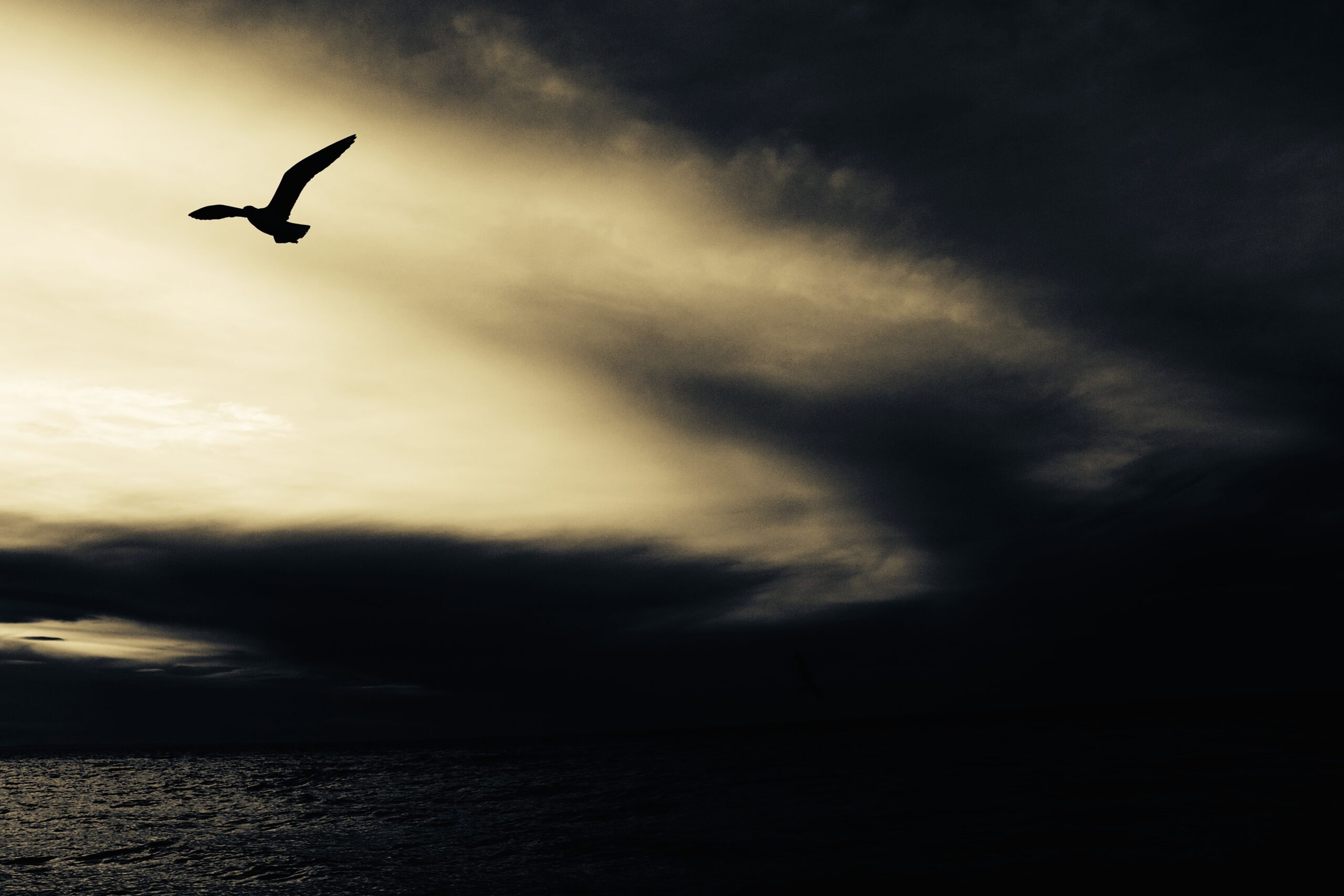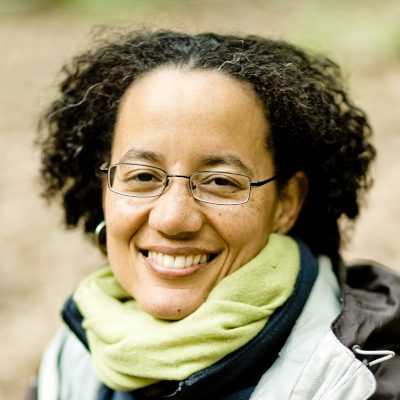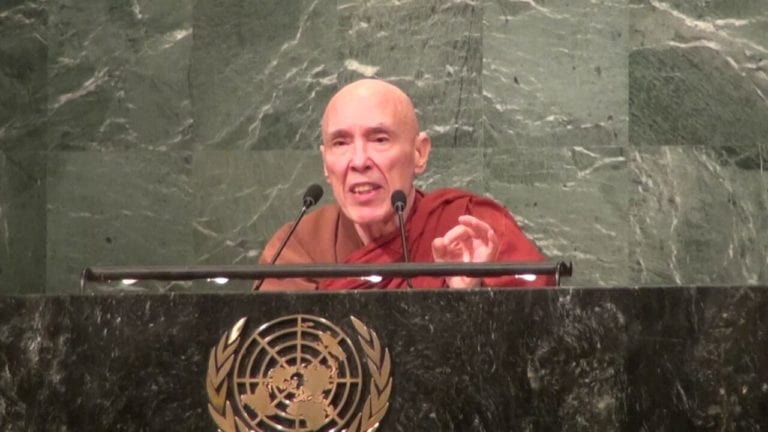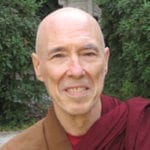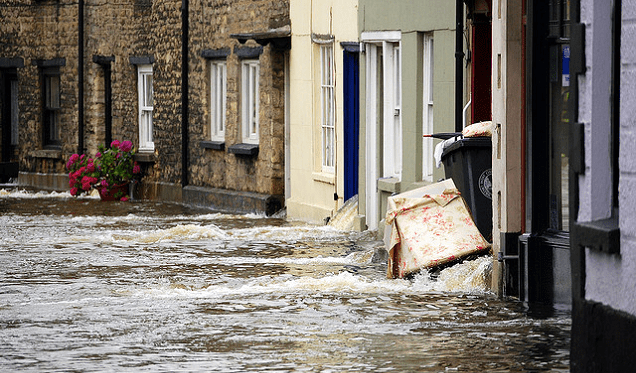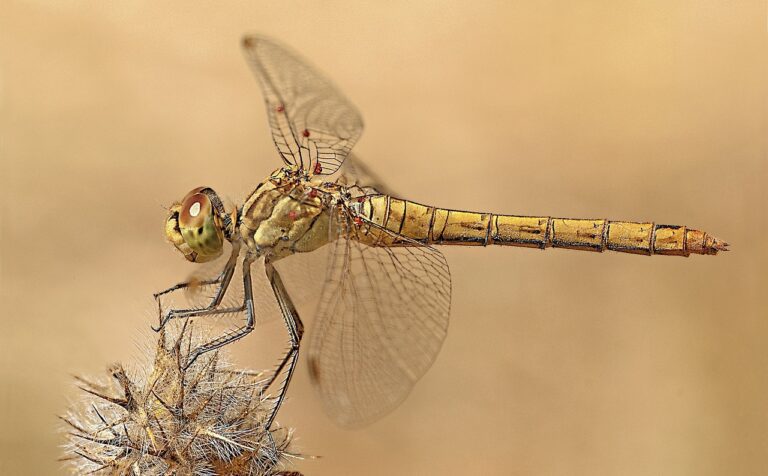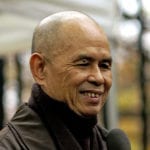At many temples in Asia, one encounters statues and paintings of Avalokitesvara, the bodhisattva of compassion. Avalokitesvara is sometimes portrayed as female, sometimes male, so we could say they are transgender—and also transcending gender. In some depictions, Avalokitesvara has a thousand arms, symbolizing all the skillful means they have of responding to suffering, and on each of these arms is an eye in the palm of the hand, the eye of wisdom.
We need the eye of wisdom in our palms. If we see deeply into a given situation, then our action will be appropriate action. But if we are caught up in our own story, not seeing the situation in its depth, in its complexity, then our action may actually cause more harm than good. We need to act, but it is also vital that we see clearly.
When 9/11 happened, I was on a bus with monastics accompanying my teacher, Thich Nhat Hanh (known to his students as Thay) to Berkeley, where he was going to be giving a talk. We were all deeply shaken by the news and wanted to respond immediately. We knew there would be a lot of people looking to Thay and the community for guidance. A group of us were brainstorming and discussing what we could do, how we could help, and we came up with a plan to go into town the next day to get resources from our archive at Parallax Press and create a press release so we could respond right away.
Whether or not we respond is not the question. We must respond. But how? And where does that response come from?
That night, when we arrived at Kim Son Monastery near Santa Cruz, we went to Thay and rather urgently shared our plan. Thay took some breaths and said, “No, I don’t want you to do that tomorrow. Tomorrow we’re all going to the beach.”
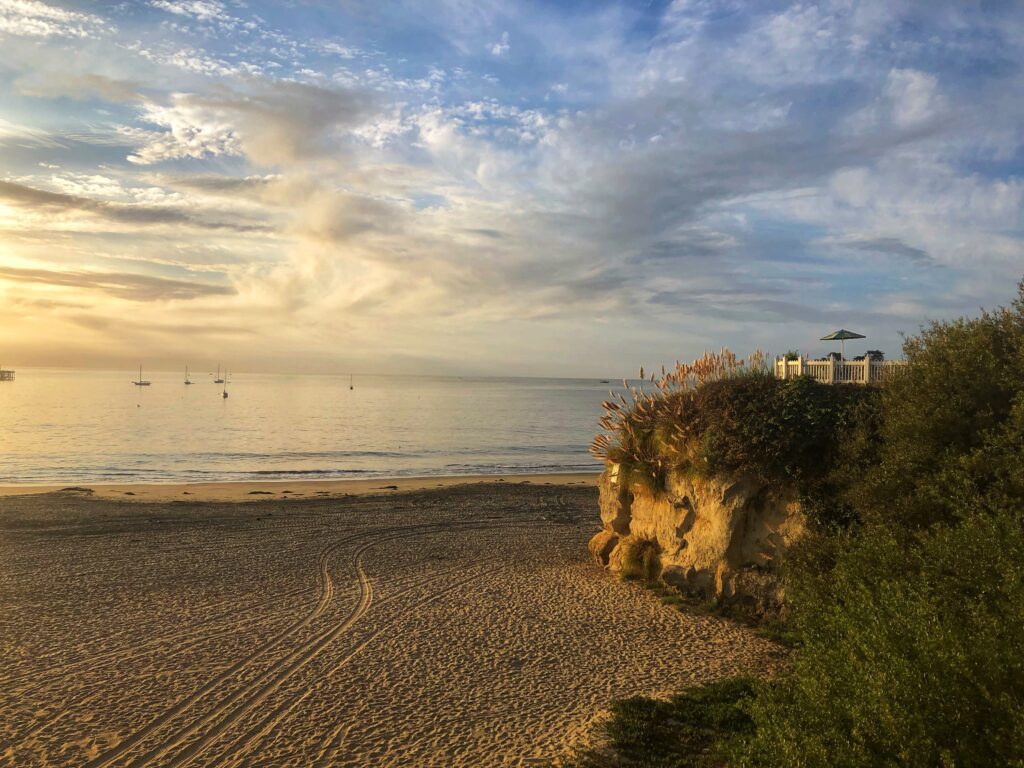
We were taken aback. The beach? There had just been a terrorist attack and we needed to respond—to act! We didn’t understand. But since he is our teacher, the next day we all went to the beach. Rather than speeding up, we slowed down and were deeply nourished. We played and ate together and swam in the ocean. It ended up being a really important time to connect with each other and feel safe. We can’t create safety for others if we don’t feel safe ourselves. The following day we did all the things we were planning to do, but those actions came out of a different place than they would have if we had gone into action right away.
I learned a lot from that. Thay probably felt quite a bit of pressure from us, his very sincere students, yet he was able to say, “No, I won’t be pushed”—not only by all the urgency in society, the collective sense of anxiety, but even these young students he was close to. It takes a great deal of strength to be able to see clearly in a situation like that. Of course, Thay spent the next many months and years responding to the 9/11 tragedy. His whole life has been a response to the tragic and profound events of suffering continuously occurring in the world.
Whether or not we respond is not the question. We must respond. But how? And where does that response come from? The way we respond is crucial.
During the war in Vietnam, Thay set up the School of Youth for Social Service (SYSS). Thousands of young people were sent out into the countryside to rebuild villages, schools, and roads to improve people’s lives. This was important work. Yet every week they would take a day of mindfulness for themselves, to refresh and come together to practice, listen to each other, share, and heal. They didn’t say, “No, this work is too urgent, we have to work seven days a week.”
This is true for all of us. In order to sustain ourselves, we have to take regular pauses.
The late American clergyman and political activist A. J. Muste said, “There is no way to peace, peace is the way.” The social workers in the SYSS in Vietnam were practicing peace, not working toward peace in frenetic ways. We don’t create peace like that. In every step we have to manifest what we want, rather than run toward something we hope will happen in the future. The future is made up of this moment.
The young people in the SYSS would rebuild bombed villages, sometimes many times over. They didn’t say, “This isn’t worth it; let’s just give up.” They weren’t rebuilding a village because they wanted a particular outcome. They weren’t dependent on a particular result. They rebuilt the village time and time again because that’s what they needed to do, not because there was any guarantee that their action was going to work and succeed and they would finally win the day.
This is an example of “There is no way to peace, peace is the way.” We’re not doing something with the expectation of a particular outcome. If we do that, we’ll burn out very soon. If we only take action when we know for sure we’ll get the result we want, then we may not do things that we don’t think will succeed, even if those actions are what’s needed. And if we do decide to take action and it doesn’t go the way we planned, we lose all of our energy and fall into despair.
It’s like conditional love and unconditional love. It’s hard to practice unconditional love, just like it’s hard to work for change without wanting it to go the way we expect. Yet if we want to survive with our energy, our hope, our love, and our enthusiasm intact, we have to look with this eye in our hand, which sees that no action goes unrecorded. An action done out of pure intent to bring joy or to relieve suffering is never lost, even if the immediate outcome is not what we want, and even if it’s the opposite. That eye in the hand of our action is the eye that sees that all we can do is what we deeply feel needs to be done. The only way we can be truly free and powerful in any action is if we do it because we know it needs to be done.
Joanna Macy and Chris Johnston speak about “active hope” as a motivating force that is not dependent on external guarantees. Active hope is rather risky—it takes courage and being okay with not-knowing. It’s alive and responsive. You take a step and then see; you make a plan, but you remain ready to adjust based on what’s going on. Active hope isn’t about having the whole plan mapped out and taking action only when you know it’s safe. Rather, it’s an attitude of “This is what feels right, so let me try it out and then be willing to respond to the feedback.” It’s a very attentive kind of practice.
The only way we can be truly free and powerful in any action is if we do it because we know it needs to be done.
Rubin Alvez, a Brazilian theologian, speaking about the source of discipline, said, “We must live by the love of what we will never see.” To do what we are called to do, we need this vast trust.
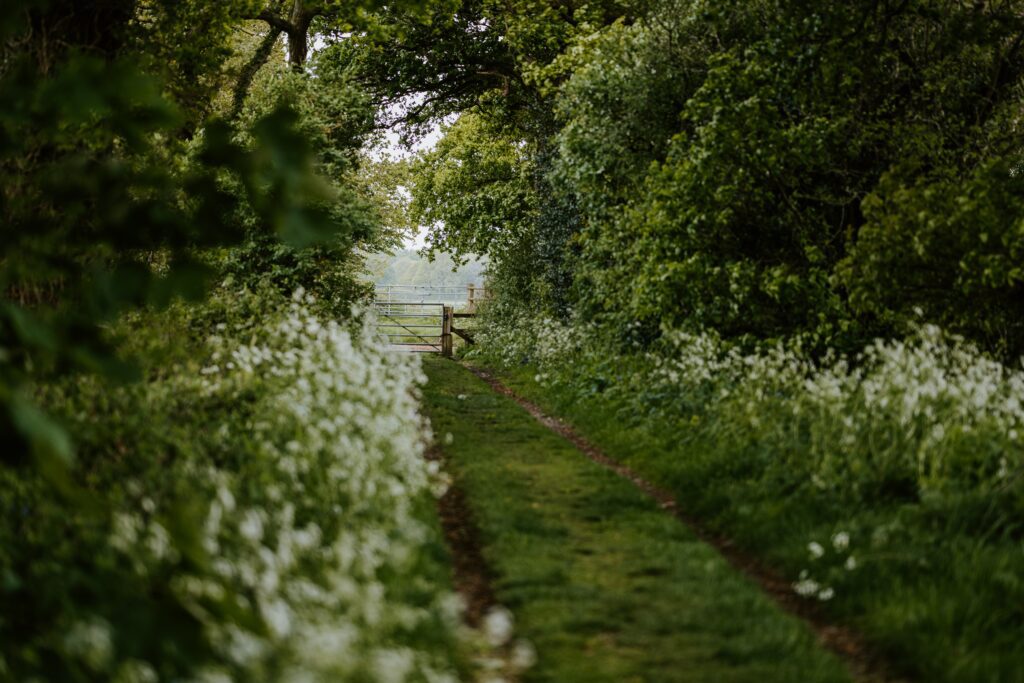
When I was a nun in the Plum Village community, I went through a period of real existential crisis about what I should be doing with my life. I was considering whether to leave the monastery, which was a huge question to be holding. I had spent my whole adult life in the monastic community, from age twenty-four to nearly forty.
At the time, I was at our center in Germany, where we were about to host two large retreats of about a thousand people each. I had been quite involved and engaged in those retreats for years, but I felt I couldn’t stay this time because of how I was feeling. So I asked the sisters if I could go to Plum Village in France instead. They were not very pleased and said I needed to ask Thay.
I went to Thay and said, “I have no space inside, and I cannot see myself staying here for these retreats. It’s too much for me.” He heard me out quietly, which he would always do, and then said, “Yes, I hear all that you are saying, and you can stay here.” In other words, you are capable of staying.
I pressed on, saying, “But it’s so tight inside. I am totally up against a wall inside.” He replied, “This is exactly the time when you take refuge in the basic practices of mindful sitting, breathing, and being aware of each step. Anytime you walk, you are aware you are taking this step; when you take a breath, you are aware you are taking this breath.”
As I listened to him speak, something in me relaxed and I realized he was right. He was seeing a capacity in me that I couldn’t see in myself. Something quickly shifted in me, and I realized that I could stay. He made it clear that I didn’t need to be on the front lines, facilitating a group, making announcements, and so on, but that I could just stay and be there with the sangha. I was willing to try.
After that, things suddenly seemed workable. Thay had given me a great gift with that teaching; my experience of both retreats was affirming, nourishing, and empowering. I did not have major responsibilities in the first retreat, but I was nourished by the energy of the sangha and participated in all the activities. By the second retreat I was ready to facilitate a group. I was once again in touch with how joyful and beautiful it is to be part of a large body of people practicing mindfulness; I realized I had the capacity to persevere and find my center in the very midst of crisis and confusion.
In those moments when it feels like there’s no way to keep going, that whatever is happening is too much, how do we touch into that sense of space? If we can breathe in and out, putting our mind on our breathing, we create space. We slow things down and let our nervous systems recalibrate and center. The external situation may not change, but we have changed in relationship to our external situation. And—this may sound weird—we can also create more time. This feeling of pressure, of stress, of not having enough time—it’s partly mind-made. It’s our way of looking, our way of being, that creates this. We get in a rush, we feel pressured, and by simply stopping or pausing we can create some spaciousness. Time becomes fuller. When we meditate, focusing on the present moment, we touch into a place that’s only accessible in the present moment, which is not constrained by our ideas of time.
We can shift our experience of things by this basic practice of being with what is here and now. So much of the stress and the feeling of being overwhelmed comes from all that we are projecting onto the future, all the fear. But in this moment, right here, there is the ability to recognize fear, to be with fear, and to not be swallowed by it. There is non-fear, and we can touch that. But if we’re running, then it’s fear that’s running the show. If we can stop, we have the chance to touch into something deeper than being overwhelmed.
In addition to centering ourselves in the present moment, another way to change our relationship to our external situation is to be in touch with joy. Thay’s insight that we should go to the beach after 9/11 was about nourishing joy. What energizes us to keep going is our sense of joy, our freshness.
Author and gift economy advocate Charles Eisenstein tells a beautiful story about the power of joy in The More Beautiful World Our Hearts Know is Possible. He describes a group of activists in Portugal who were becoming very burnt out. They were trying to address the most urgent issue, and one person suggested they would like to organize a sharing cooperative, like a time bank. This person was highly motivated and passionate about it. But the group squashed the idea because it was not the most urgent thing, so this person’s freshness was suppressed. Over time, the energy of the group began to decrease; they lost motivation, they lost hope, and they began to have more conflict with each other.
If we are to help bring about peace and relieve this suffering, we must act and live in ways that create peace now, in each moment.
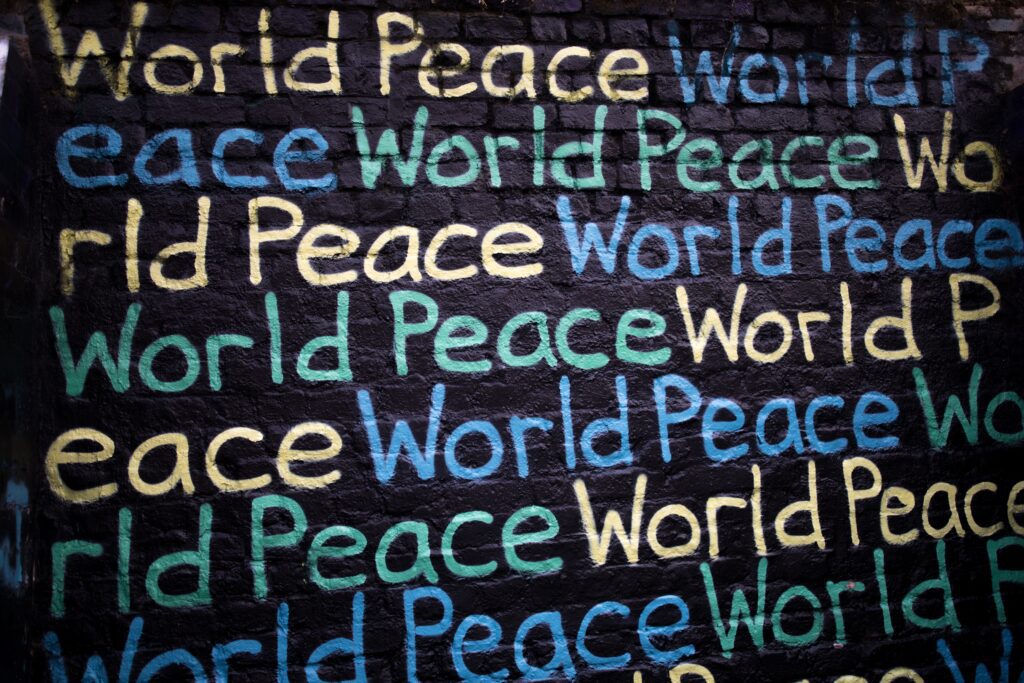
But they were intelligent and decided to pause and take a look at what was going on in their group dynamic. They reflected on how they were approaching their work for change and realized they needed to prioritize each other, their relationships, and take good care of each other. And they also needed to be doing what they loved.
So the group decided that anytime someone was not doing okay, they would stop and see how to take care of that person and keep them strong. They also decided they would no longer make the most urgent thing their priority. They returned to the ideas that people had shared that had gotten squashed, and they decided to support them. Then, interestingly, they began to get a lot more done. They were much more productive, much more successful in their work, and also much happier.
It’s important to ask, how are we taking care of each other? This too is the practice of “There is no way to peace, peace is the way.” Before every meeting, we can take a few mindful breaths. There are many companies, organizations, and schools that begin their meetings or classes with a bell so that everyone can take some mindful breaths and re-center themselves. It is beautiful to nourish this connection to each other by stopping in this way. It allows us to be a full human being, not looking at our phones all the time, feeling this constant, chronic internal pressure—the sense of “I can’t actually be here because I need to be there.” That’s not being a full human being. In every interaction, can we stop and nourish ourselves? Can we look clearly, slow down enough to see each other, to see this person needs support, this person is about to burn out? Can we bring in elements of play, joy, humor, surprise, and appreciation?
As we work, it is also important to celebrate our successes and accomplishments throughout the process, not just when our project is complete. This keeps the freshness alive and keeps us connected to the goodness of our work rather than simply focused on some distant outcome at the end. It’s also true that there is no way to celebration, celebration is the way!
There is so much that needs to be done, so much suffering to respond to as humanity heads ever faster toward peril and destruction. If we are to help bring about peace and relieve this suffering, we must act and live in ways that create peace now, in each moment. Seeing with the eye of wisdom in our palm, we can act without expectation while nourishing our connection and joy. We must not forget to take care of ourselves and each other so that we don’t burn out. Sometimes, rather than letting urgency rule the day, that may mean pausing to go to the beach. We can deeply attend to our breath and our steps, knowing this will only strengthen us for the significant work ahead.
This article was originally published in the Summer 2020 issue of Buddhadharma: The Practitioner’s Guide. It is reprinted here with permission.

